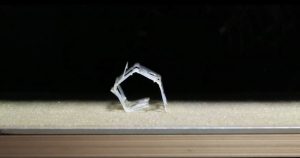Working from a beachside shack on California’s Monterey Bay, Nate Lindsey fired a stream of infrared laser pulses down a long fiber-optic cable extending onto the ocean floor. The miles-long cable had been there for a decade, transmitting data to and from scientific instruments on the seafloor, but Lindsey, a geoscientist at UC Berkeley, was trying something new. He and his team had disconnected the cable from all its usual sensors so they could use the fiber itself to sense vibrations on the ocean floor.
By monitoring how light beamed and bounced through the transparent fiber, Lindsey’s team was able to describe the texture and topography of the earth it was buried in. As they report in the journal Science today, the method led them to discover a new underwater fault 5 miles from the Monterey Bay coastline. The technique could potentially help monitor and characterize swaths of unmapped ocean floor, using the so-called dark fiber that telecom companies have already buried across oceans but do not actively use.
“To my knowledge, this is the first example of this technique used under the sea,” says geoscientist Philippe Jousset of the GFZ German Research Centre for Geosciences, who has used fiber to sense earthquakes and volcanic activity on land. “And with it, they could observe phenomena we were not aware of before.”
Called distributed acoustic sensing, this technique is a sharp departure from how earth scientists typically monitor the ocean floor. Conventional underwater seismometers, which can cost $100,000 apiece, sense vibrations only at a single location. Lindsey says that a 12-mile stretch of fiber-optic cable served the role of 10,000 conventional instruments. So exploiting existing, unused fiber networks could be a practical strategy for mapping the ocean floor. Jousset, for example, has already collaborated with Icelandic and Italian telecom companies to use their fiber to measure seismic activity on land.
To find the fault off Monterey Bay, Lindsey’s team spent four days in 2018 sending light pulses down the fiber, the same way it would transmit data. Most of the light travels straight through the clear, hair-thin stretch of glass. But because no fiber is perfectly transparent, some tiny amount of light will always scatter, bouncing back toward shore off microscopic flaws in the glass. From his shack onshore, Lindsey could detect this reflected light. If the earth surrounding some part of the fiber is stretched or compressed in any way—perhaps by an earthquake—the character of the reflected light changes. By timing how long it took the pulse to fire, bounce off the impurity, and return to shore, Lindsey could locate where the disturbance occurred.
During their four-day experiment, a small earthquake rumbled about 30 miles away. The vibrations shook the earth near the fiber, and Lindsey’s team then mapped how the seismic waves moved through the area. From their analysis, they inferred the presence of an unexpected crack in the ocean floor: a new fault.
By mapping new faults, fiber cables could fill a much needed gap in scientists’ knowledge of the oceans. Less than 20 percent of the world’s earthquake sensors are in the oceans, even though they make up 70 percent of Earth’s surface area. More detailed maps will help scientists make more accurate predictions about earthquakes and tsunamis. “Locating small faults gives us more knowledge of the bigger faults and where the potential hazards could be,” says Jousset.
One outstanding challenge is that fiber sensors produce massive quantities of data. Lindsey’s team collected 4 terabytes in this experiment, and scaling up to the entire ocean would generate an untenable amount of data. Some researchers have begun to investigate methods for compressing the data with machine learning, says Jousset.
Still, Lindsey thinks the technology is mature enough to become a worldwide utility over the next decade. “There are really high hazard areas where this would be a great monitoring tool,” he says, citing locations off the coasts of Taiwan, India, and the western US, where telecom cables are already buried. That fiber could watch for earthquakes while you Netflix and chill.
More Great WIRED Stories
- The tech-obsessed, hyper-experimental restaurant of the future
- Why the Tesla Cybertruck looks so weird
- Starlings fly in flocks so dense they look like sculptures
- A journey to Galaxy’s Edge, the nerdiest place on earth
- Burglars really do use Bluetooth scanners to find laptops and phones
- 👁 A safer way to protect your data; plus, the latest news on AI
- ✨ Optimize your home life with our Gear team’s best picks, from robot vacuums to affordable mattresses to smart speakers.



